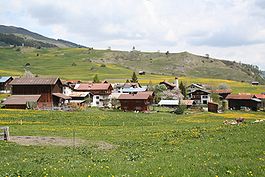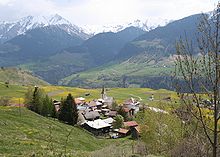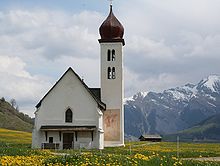- Degen, Switzerland
-
For other uses, see Degen (disambiguation).
Degen Country Switzerland 
Canton Graubünden District Surselva 46°42′N 9°10′E / 46.7°N 9.167°ECoordinates: 46°42′N 9°10′E / 46.7°N 9.167°E Population 249 (Dec 2009)[1] - Density 37 /km2 (96 /sq mi) Area 6.72 km2 (2.59 sq mi) Elevation 1,122 m (3,681 ft) Postal code 7145 SFOS number 3594 Surrounded by Vella, Vignogn, Suraua, Obersaxen. Website www.gemeinde-degen.ch
SFSO statisticsView map of Degen Degen is a municipality in the district of Surselva in the Swiss canton of Graubünden. Until 1983, it was officially known as Igels.
Contents
History
Degen is first mentioned about 840 as Higenae/Egenae. Rumein was mentioned at about the same time as villa Ramnensis, and in 1325 Vattiz was mentioned as Vatigis.[2]
Geography
Degen has an area, as of 2006[update], of 6.8 km2 (2.6 sq mi). Of this area, 78.1% is used for agricultural purposes, while 10.9% is forested. Of the rest of the land, 4% is settled (buildings or roads) and the remainder (7%) is non-productive (rivers, glaciers or mountains).[3]
The municipality is located in the Lugnez sub-district of the Surselva district. It is on a terrace about 200 m (660 ft) above the Glenner valley floor. It consists of the village of Degen and the hamlets of Rumein und Vattiz. Until 1983 Degen was known as Igels.[4] The municipalities of Cumbel, Degen, Lumbrein, Morissen, Suraua, Vignogn, Vella, and Vrin are considering a merger for some time in the future into a new municipality that will be known as Val Lumnezia.[4]
Coat of arms
The municipal coat of arms is Per bend Sable a Mullet Or and of the last a Bend embattled bretessé Sable in bend couped of the first.[5]
Demographics
Degen has a population (as of 31 December 2009) of 249.[1] As of 2008[update], 5.3% of the population was made up of foreign nationals.[6] Over the last 10 years the population has decreased at a rate of -14.6%. Most of the population (as of 2000[update]) speaks Romansh(73.7%), with German being second most common (20.6%) and Albanian being third ( 3.6%).[3]
As of 2000[update], the gender distribution of the population was 53.8% male and 46.2% female.[7] The age distribution, as of 2000[update], in Degen is; 30 children or 12.1% of the population are between 0 and 9 years old and 34 teenagers or 13.8% are between 10 and 19. Of the adult population, 15 people or 6.1% of the population are between 20 and 29 years old. 34 people or 13.8% are between 30 and 39, 36 people or 14.6% are between 40 and 49, and 40 people or 16.2% are between 50 and 59. The senior population distribution is 28 people or 11.3% of the population are between 60 and 69 years old, 16 people or 6.5% are between 70 and 79, there are 12 people or 4.9% who are between 80 and 89 there are 2 people or 0.8% who are between 90 and 99.[6]
In the 2007 federal election the most popular party was the CVP which received 60.8% of the vote. The next three most popular parties were the SVP (16.2%), the FDP (14.9%) and the SP (8.1%).[3]
The entire Swiss population is generally well educated. In Degen about 59.7% of the population (between age 25-64) have completed either non-mandatory upper secondary education or additional higher education (either University or a Fachhochschule).[3]
Degen has an unemployment rate of 0.4%. As of 2005[update], there were 42 people employed in the primary economic sector and about 23 businesses involved in this sector. 17 people are employed in the secondary sector and there are 3 businesses in this sector. 18 people are employed in the tertiary sector, with 10 businesses in this sector.[3]
The historical population is given in the following table:[2]
year population 1808 232 1850 255 1900 214 1950 323 2000 247 Heritage sites of national significance
The Chapel of St. Sebastian is listed as a Swiss heritage site of national significance.[8]
References
- ^ a b Swiss Federal Statistical Office, MS Excel document – Bilanz der ständigen Wohnbevölkerung nach Kantonen, Bezirken und Gemeinden (German) accessed 25 August 2010
- ^ a b Degen in German, French and Italian in the online Historical Dictionary of Switzerland.
- ^ a b c d e Swiss Federal Statistical Office accessed 23-Nov-2009
- ^ a b Amtliches Gemeindeverzeichnis der Schweiz published by the Swiss Federal Statistical Office (German) accessed 23 September 2009
- ^ Flags of the World.com accessed 23-Nov-2009
- ^ a b Graubunden Population Statistics (German) accessed 21 September 2009
- ^ Graubunden in Numbers (German) accessed 21 September 2009
- ^ Swiss inventory of cultural property of national and regional significance 21.11.2008 version, (German) accessed 23-Nov-2009
External links
- Official Web site
- Degen in German, French and Italian in the online Historical Dictionary of Switzerland.
Andiast | Breil/Brigels | Castrisch | Cumbel | Degen | Disentis/Mustér | Duvin | Falera | Ilanz | Laax | Ladir | Lumbrein | Luven | Medel (Lucmagn) | Morissen | Mundaun | Obersaxen | Pigniu | Pitasch | Riein | Rueun | Ruschein | Safien | Sagogn | Schlans | Schluein | Schnaus | Sevgein | Siat | St. Martin | Sumvitg | Suraua | Tenna | Trun | Tujetsch | Valendas | Vals | Vella | Versam | Vignogn | Vrin | Waltensburg/Vuorz
Graubünden | Districts of Canton Graubünden | Municipalities of the canton of Graubünden
 Categories:
Categories:- Municipalities of Graubünden
- Municipalities of Switzerland
- Cultural property of national significance in the canton of Graubünden
Wikimedia Foundation. 2010.





